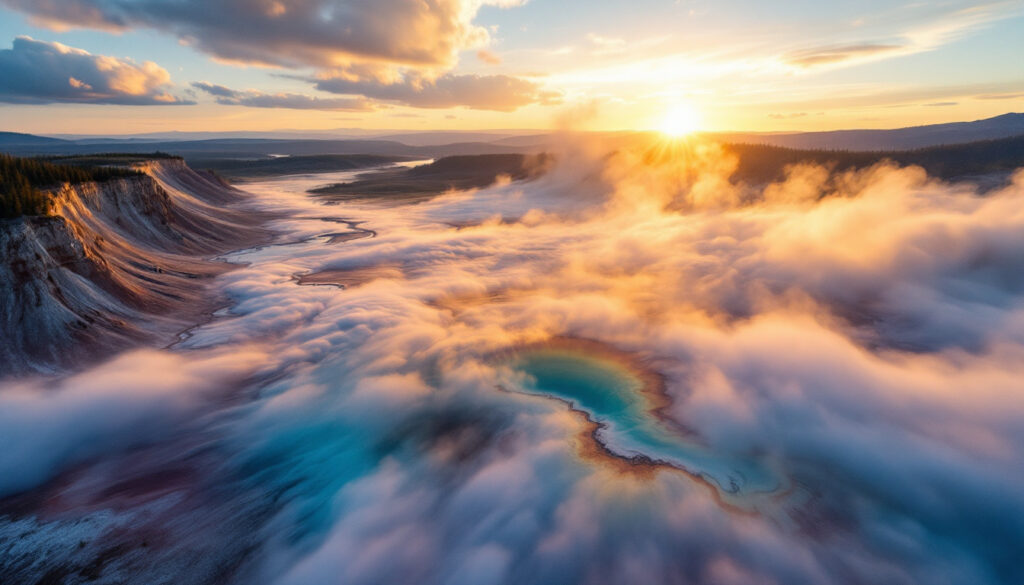How Did Scientists Discover the Yellowstone Hotspot's Influence Beyond Wyoming?
The Yellowstone hotspot has profoundly influenced the geological landscape of the western United States, leaving a trail of volcanic deposits spanning 16 million years. Recent research has overturned long-held assumptions about the origin of ash beds in the Pacific Northwest, revealing that many thick deposits previously attributed to Cascade volcanoes actually originated from Yellowstone-related eruptions in southern Idaho. This discovery, spearheaded by geochemist Dr. Barbara Nash, has reshaped understanding of regional volcanic history through advanced geochemical fingerprinting and stratigraphic analysis. The study of ore deposits geology has been enhanced by these findings. Key insights include the identification of 165 distinct Yellowstone eruptions, distinct mineralogical differences between Yellowstone and Cascade ashes, and the role of fluvial reworking in creating anomalously thick ash layers. These insights provide critical frameworks for dating geological formations and reconstructing ancient environments.
The Fingerprinting Revolution in Volcanic Glass Analysis
The breakthrough in tracing ash deposits to their sources began in the 1970s with the development of geochemical fingerprinting techniques. Dr. Barbara Nash, a pioneering geochemist at the University of Utah, played a pivotal role in establishing that volcanic centers produce glass with unique chemical signatures. By analyzing major elements like silica, iron, and calcium, researchers could distinguish ashes from different volcanic provinces. For example, Yellowstone ashes exhibit lower calcium content and distinct silica-to-iron ratios compared to Cascade deposits, which contain higher calcium and abundant hornblende crystals. This methodological leap enabled precise correlations between ash layers and their eruption sources, even across vast distances.
The Yellowstone Hotspot Timeline Revealed
Through decades of fieldwork and laboratory analysis, researchers cataloged 165 eruptions linked to the Yellowstone hotspot over 16 million years. Eruption frequency varied significantly: the early Miocene period saw approximately 10 eruptions per million years, while the last 4 million years have witnessed only three major events. This decline parallels the hotspot's migration across the Snake River Plain, with older eruptions concentrated in Nevada and Oregon and younger activity centered in Wyoming. The plate tectonics influence on this migration has been thoroughly documented by geologists. Isotopic studies of neodymium and hafnium further confirmed the continental crustal signature of post-15-million-year Yellowstone eruptions, contrasting sharply with the subduction-related chemistry of Cascade volcanoes.
What Makes Yellowstone Ash Different from Cascade Volcanic Deposits?
Field Identification Techniques
Geologists can preliminarily differentiate Yellowstone and Cascade ashes in the field using mineralogical criteria. Yellowstone deposits typically lack hornblende and biotite, minerals ubiquitous in Cascade-derived ash due to their shallower magma chambers. For instance, at Wenass Lake, Washington, a 2-meter-thick Yellowstone ash bed underlies Cascade pumice layers rich in hornblende, a visual contrast observable with a hand lens. Thickness also serves as a clue: Yellowstone layers often reach 30 feet due to secondary reworking, whereas primary Cascade airfall rarely exceeds a few inches.
Laboratory Chemical Signatures
Detailed geochemical analysis reveals deeper distinctions. Yellowstone ashes show silica concentrations around 70–75%, with iron oxide below 2% and calcium oxide under 1%, reflecting their rhyolitic origin from deep crustal melts. In contrast, Cascade ashes exhibit more variable compositions (60–70% silica) and higher calcium (3–5%), consistent with subduction-zone magmatism. Basin and Range ashes, such as those from the Bishop Tuff, display extreme silica enrichment (75–77%) and negligible iron, forming a third diagnostic group. These chemical "fingerprints" allow precise source attribution even for altered or mixed deposits.
Isotopic Evidence
For ambiguous cases, isotopic analysis provides definitive answers. Yellowstone ashes younger than 15 million years exhibit εNd values of -10 to -15 and εHf of -5 to -10, indicating significant crustal assimilation. Cascade ashes, by contrast, have εNd near -2 and εHf near +5, mirroring their mantle-derived origins. These differences, detectable via mass spectrometry, resolve long-standing debates over ash provenance in regions like the Ellensburg Formation, where thick layers were misattributed to local volcanism for decades.
How Do Massive Ash Deposits Form Far from Their Source?
The Reworking Process
The exceptional thickness of ash beds in Washington and Idaho results not from direct fallout but from post-eruption fluvial reworking. Primary airfall from Yellowstone super-eruptions rarely exceeds 6–12 inches, but water transport redistributes ash into sedimentary basins, amplifying thickness 20–30 times. At Sentinel Gap, Washington, the 10.5-million-year-old Cougar Point Tuff VII attains 30 feet of cumulative deposition through successive flooding events, evidenced by cross-bedding and ripple marks. Similar processes concentrated ash in the Ellensburg Formation, where channelized flows deposited laminated sequences over centuries.
Wind Patterns and Super-Eruptions
Although prevailing westerly winds dominate Pacific Northwest weather, Yellowstone plumes reached Washington via two mechanisms. First, super-eruptions like the 8.99-million-year-old McMullen Creek event produced buoyant columns penetrating the stratosphere, enabling transcontinental transport. Second, ash entering the jet stream circulated globally, with traces identified as far as the Gulf of Mexico via the Mississippi drainage. Computational models suggest that eruptions exceeding 500 km³ of ejecta could overcome regional wind patterns, blanketing areas up to 1,500 km downwind. The Yellowstone hotspot's geological history shows it has been influencing the region for millions of years.
Where Can You Find Yellowstone Ash in Washington State?
Key Locations for Yellowstone Ash in Washington
Dr. Nash's research identified multiple Washington sites with Yellowstone-derived ash. At Wenass Lake, a 2-meter bed of glass shards overlies Miocene basalts and underlies Cascade pumice, demonstrating sequential volcanic influences. Sentinel Gap's Cougar Point Tuff VII, exposed in a Yakima River Canyon quarry, contains pristine glass shards with 0.12% chlorine, confirming its post-8-million-year age. The Yakima River Canyon also hosts ash previously misidentified as Mazama (Cascade) deposits, now reclassified as Cougar Point Tuff IX through electron microprobe analysis.
The Ellensburg Formation Mystery Solved
For over 50 years, geologists ascribed all Ellensburg Formation ashes to Cascade sources due to their proximity to Mount Rainier and Mount St. Helens. However, Nash's 2012 study revealed that the thickest beds, once thought to be Mazama or Glacier Peak products, correlate geochemically with Yellowstone's Heise volcanic field. Chlorine concentrations exceeding 0.1% in these layers indicate eruption ages younger than 8 million years, coinciding with the hotspot's passage through southern Idaho. This reinterpretation underscores the importance of geochemical validation in stratigraphy.
How Does Ash Correlation Advance Scientific Understanding?
Creating Chronostratigraphic Frameworks
Ash layers serve as isochronous markers, enabling precise dating across disparate sedimentary basins. In the Snake River Plain, the 4.65-million-year-old Kilgore Tuff anchors regional chronologies, correlating to sites as distant as Oregon's Baker City. Such markers allow paleontologists to synchronize fossil records, revealing that mammalian speciation events in the Miocene coincided with volcanic pulses. Archaeologists similarly benefit; Yellowstone obsidian artifacts in New England trade networks, dated via hydration rinds, map pre-Columbian migration routes.
Archaeological Applications
Beyond geology, ash fingerprinting illuminates human history. In Ethiopia, Nash's work linked 2.5-million-year-old stone tools to obsidian sources 200 km away, proving early hominins engaged in long-distance resource exchange. In Washington, Cougar Point Tuff artifacts at Celilo Falls demonstrate trade between Columbia Plateau tribes and Yellowstone-area groups circa 7,000 BCE. These findings rely on the same geochemical techniques used in volcanic stratigraphy, bridging disciplines through shared methodology. This research complements our understanding of ancient to modern gold mining techniques, as many mineral deposits are associated with volcanic activity.
FAQ About the Yellowstone Hotspot and Ash Deposits
How old are the Yellowstone ash deposits found in Washington state?
Most Washington ashes date to 10–12 million years, coinciding with the Cougar Point Tuff eruptions from the Heise volcanic field. The Sentinel Gap deposit, for instance, yields argon-argon ages of 10.5 ± 0.3 million years, aligning with hotspot migration rates of 4 cm/year.
Why are some ash deposits so much thicker than others?
Primary airfall accounts for less than 10% of total thickness in deposits like the Ellensburg Formation. Fluvial reworking, particularly in enclosed basins, remobilizes ash from uplands, creating stacked sequences exceeding 30 feet. At Yakima River Canyon, cyclic flooding deposited 1–2 cm laminations over millennia, preserved by rapid basalt burial.
Can you determine the age of an ash deposit without radiometric dating?
Chlorine content provides a rapid age proxy for Yellowstone ashes. Deposits with >0.1% chlorine postdate 8 million years, as younger magmas assimilated chloride-rich crustal rocks. This method corroborates argon-argon dates within ±0.2 million years, offering field-expedient age estimates.
How far can ash travel from a super-eruption?
The 8.99-million-year-old Grey's Landing Tuff reached Kansas as primary airfall, 1,500 km from its Idaho source. Finer particles circumnavigated the globe, with ash layers identified in Gulf of Mexico cores 2,300 km downstream. Similar transport mechanisms explain the distribution of epithermal deposits formation elements from volcanic sources.
What tools do geologists use to identify ash sources in the field?
A 10× hand lens suffices to detect hornblende in Cascade ashes, absent in Yellowstone deposits. Portable XRF analyzers now enable in situ chemical screening, identifying key elements like zirconium and strontium within minutes. This technology has revolutionized field identification of Carlin gold deposits and other mineral formations.
Ready to Stay Ahead in Mineral Discovery Investing?
Gain instant alerts on significant ASX mineral discoveries with Discovery Alert's proprietary Discovery IQ model, turning complex volcanic and geological data into actionable investment opportunities. Explore why historic discoveries generate substantial returns by visiting Discovery Alert's dedicated discoveries page and begin your 30-day free trial today to position yourself ahead of the market.




